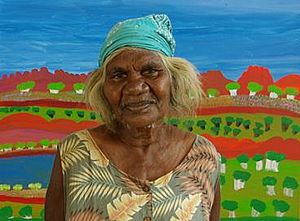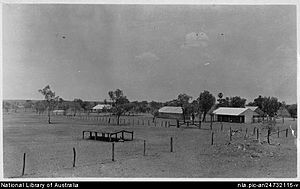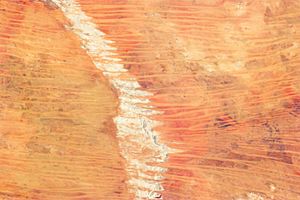Daisy Andrews facts for kids
Quick facts for kids
Munmarria Daisy Andrews
|
|
|---|---|
 |
|
| Born | c. 1934 or 1935 |
| Died | January 2015 |
| Nationality | Australian |
| Occupation | Artist |
|
Notable work
|
Lumpa Lumpa (wet time) landscape |
| Spouse(s) | Adam Andrews |
| Children | eight |
| Awards | Telstra Award (National Aboriginal and Torres Strait Islander Art Awards) |
Daisy Andrews (born around 1934 or 1935, died January 2015) was an Australian artist. She belonged to the Walmajarri desert people. She started painting later in life, first by drawing pictures for stories told by people in her community. Soon, her own paintings were shown in art exhibitions all over Australia.
She was famous for her bright red paintings of the mountains in the Great Sandy Desert. In 1994, she won a major award called the Telstra Award at the National Aboriginal and Torres Strait Islander Art Awards (NATSIAA) for her painting Lumpa Lumpa (wet time) landscape.
Daisy Andrews' artworks are kept in important places like the Australian National Gallery, the Museum and Gallery of Northern Territory, and the Queensland Art Gallery. A special woven version of one of her paintings is even displayed in the Australian Embassy in Tokyo, Japan.
Contents
Daisy Andrews' Early Life
Munmarria Daisy Andrews was born around 1934 or 1935 at Cherrabun station. Her parents, Jack Pinden and Ruby Jarlkurr, were part of the Walmajarri desert tribe. When Daisy was born, her family was moving north from the desert. They were moving because of dry weather, disagreements between tribes, and new settlers using their water sources. Daisy's father had three wives, and she had an older brother named Boxer Yankarr and a sister.
Daisy's father tried to take his family back to their desert home. However, police often stopped them. Sometimes, her father was forced to return to the city. Eventually, the family was sent to a government-run place called Moola Bulla.
Her Career as an Artist
After 1981, Daisy Andrews began taking classes to learn reading and writing English. She attended the Karrayili Adult Education Centre. The men in her class started writing stories about their early memories. This inspired Daisy and the other women to illustrate these stories with art. Soon, Daisy began to focus on painting her own artworks.
In 1991, Daisy took part in her first group art show in Adelaide. Two years later, her art was shown in a special exhibition called "Images of Power" at the National Gallery of Victoria. In 1994, she won the main Telstra award at the National Aboriginal and Torres Strait Islander Art Awards (NATSIAA). She won for her painting called Lumpa Lumpa (wet time) landscape.
Between 1991 and 2016, Daisy Andrews' art was shown in over 40 group exhibitions across Australia. She also had her own art shows in cities like Brisbane, Sydney, Perth, and Melbourne. In 1996, she painted a very large backdrop, 12 meters long, for an opera called Alcina by the West Australian Opera.
Besides the National Gallery of Victoria, her art is also in the Australian National Gallery, the Museum and Gallery of Northern Territory, and the Queensland Art Gallery. One of her artworks was even turned into a woven tapestry by the Australian Tapestry Workshop. This beautiful tapestry is now displayed in the Australian Embassy in Tokyo, Japan.
Daisy Andrews' Artistic Style
Throughout her time as an artist, Daisy Andrews mostly painted the northern mountain ranges of the Great Sandy Desert. She showed the landscape in all different seasons and weather conditions. Daisy often used deep red colors in her paintings. She shared that many of her artworks were inspired by important family stories about her people's history and their connection to the land. She once said, "When I paint, I think of blood," showing the deep meaning behind her art.
Her Personal Life
When she was a young woman, Daisy met a Bunuba man named Adam Andrews. They fell in love and got married. Daisy described their feelings as "young days love." They had eight children together.
Daisy Andrews was also a singer, not just a painter. She shared her knowledge of traditional songs and ceremonies with young people in Australia. She helped start the Kimberley Language Resource Centre. She also played a role in setting up the Karrayili Adult Education Centre, where she first began her art journey.
Her Passing
Daisy Andrews passed away in January 2015.



